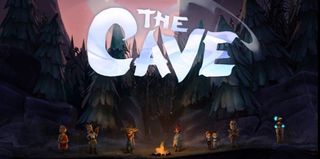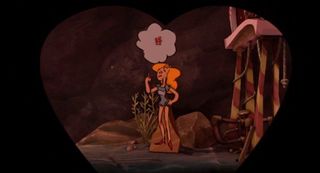The Cave preview - hands-on with Ron Gilbert's latest adventure game

Seven characters enter a cave three at a time. Each is an archetype fit for a Hanna-Barbera cartoon—the hillbilly, the adventurer, the twins, the knight, the scientist, and the monk—and each is harboring a memory or fear terrible and violent enough to also have appeared in a '50s-era cartoon. Whether they've done or will do these awful things is intentionally unclear, but for our sake, their journey of self-discovery has a narrator: the cave. Not in a metaphorical sense, like how a 300-year-old building "really tells a story" according to tourists who are inexplicably all architecture experts. It's a sentient, talking cave.
Over two decades in the making
Legendary designer Ron Gilbert has been working on the idea for The Cave for over 25 years—it even predates his Commodore 64 classic, Maniac Mansion. The talking cave was always part of the plan, but the trailers suggest that his idea has radically transformed since he worked on Maniac Mansion and Monkey Island: it looks like a platformer, with timed jumps and everything.
After playing the hillbilly's story, I can confirm that at least one of The Cave's chambers is definitely a Ron Gilbert adventure game. The running and jumping kept me active, and now and then I had to stick a landing, but it was mostly in pursuit of puzzle solutions. Death is possible, but it isn't failure: if a character falls too far or drowns, he or she is whisked back to solid ground.
Gilbert calls The Cave an "evolution of adventure games." By emphasizing constant movement instead of the classic click-and-take-a-terribly-slow-stroll-across-the-screen approach, players are always occupied while they work out puzzles. For me, it's like pacing to think.
Another evolution is the lack of an inventory. I was skeptical, but the limitation prevents overabundance of items from being used as a complexity crutch. Instead of grabbing everything I saw and hoping it would be useful later (if I even remembered I had it by then), I usually identified a problem before finding the item needed to solve it. When I discovered a barbell, for example, I knew just where I should take it, if not what I was going to do with it when I got there.
A hillbilly romantic

The hillbilly's story, like the others, is directed and narrated by the sentient cave. The cave has materialized a carnival, and the hillbilly is motivated to impress a cardboard stand-in for "The Amazing Two-Legged Woman"—the one who got away, we assume—by scoring enough carnival tickets to gift her a teddy bear. Winning carnival games earns tickets, and the barbell seemed most appropriate for the weight guessing game. If the cardboard carny guessed my weight incorrectly, I would win, but he wasn't fooled when I carried the barbell onto the scale. I won't spoil the solution, but it was satisfying: not an absurd logical leap, but not instantly obvious, either.
That weight puzzle was a one-man job, but many required teamwork. Before starting the game, a team of three characters is chosen, and each brings their own story area and special ability. For this demonstration, the hillbilly, adventurer, and monk had been recruited. The teamwork is pretty simple: the monk pulls a lever while the adventurer turns a dial, the adventurer rides a merry-go-round while the monk mans the generator; the hillbilly traverses a flooded passageway with his special ability—holding his breath indefinitely—while the others wait for him to clear a path.
PC Gamer Newsletter
Sign up to get the best content of the week, and great gaming deals, as picked by the editors.

This also means that most puzzles have multiple solutions. I wouldn't be playing the hillbilly's story if he weren't one of my characters, so his super-human lungs are required, but my other characters could have been any combination of the remaining six. For one puzzle, I used the monk's telekinesis ability to retrieve an inaccessible item, but nearby bits of the environment clearly offered different solutions for different parties.

Tyler grew up in Silicon Valley during the '80s and '90s, playing games like Zork and Arkanoid on early PCs. He was later captivated by Myst, SimCity, Civilization, Command & Conquer, all the shooters they call "boomer shooters" now, and PS1 classic Bushido Blade (that's right: he had Bleem!). Tyler joined PC Gamer in 2011, and today he's focused on the site's news coverage. His hobbies include amateur boxing and adding to his 1,200-plus hours in Rocket League.
Most Popular

